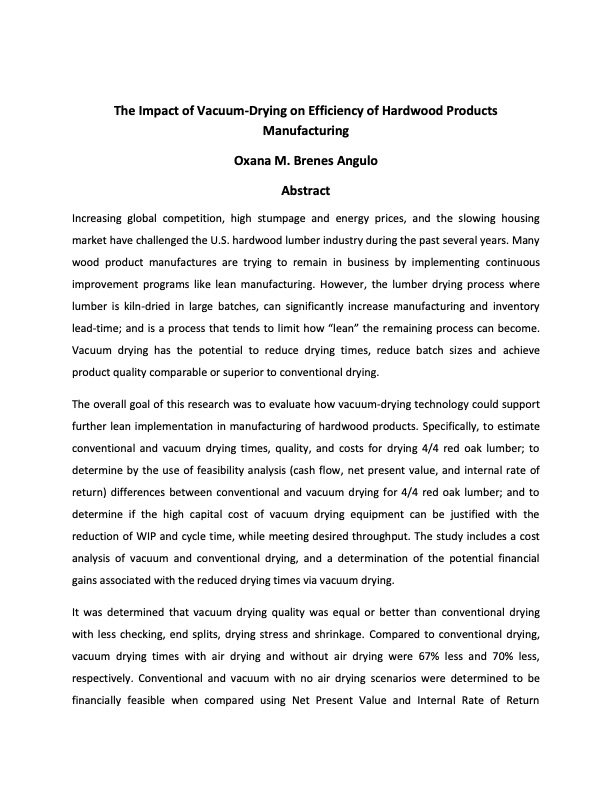
PDF Publication Title:
Text from PDF Page: 002
The Impact of Vacuum-Drying on Efficiency of Hardwood Products Manufacturing Oxana M. Brenes Angulo Abstract Increasing global competition, high stumpage and energy prices, and the slowing housing market have challenged the U.S. hardwood lumber industry during the past several years. Many wood product manufactures are trying to remain in business by implementing continuous improvement programs like lean manufacturing. However, the lumber drying process where lumber is kiln-dried in large batches, can significantly increase manufacturing and inventory lead-time; and is a process that tends to limit how “lean” the remaining process can become. Vacuum drying has the potential to reduce drying times, reduce batch sizes and achieve product quality comparable or superior to conventional drying. The overall goal of this research was to evaluate how vacuum-drying technology could support further lean implementation in manufacturing of hardwood products. Specifically, to estimate conventional and vacuum drying times, quality, and costs for drying 4/4 red oak lumber; to determine by the use of feasibility analysis (cash flow, net present value, and internal rate of return) differences between conventional and vacuum drying for 4/4 red oak lumber; and to determine if the high capital cost of vacuum drying equipment can be justified with the reduction of WIP and cycle time, while meeting desired throughput. The study includes a cost analysis of vacuum and conventional drying, and a determination of the potential financial gains associated with the reduced drying times via vacuum drying. It was determined that vacuum drying quality was equal or better than conventional drying with less checking, end splits, drying stress and shrinkage. Compared to conventional drying, vacuum drying times with air drying and without air drying were 67% less and 70% less, respectively. Conventional and vacuum with no air drying scenarios were determined to be financially feasible when compared using Net Present Value and Internal Rate of ReturnPDF Image | Impact of Vacuum-Drying on Efficiency of Hardwood Products

PDF Search Title:
Impact of Vacuum-Drying on Efficiency of Hardwood ProductsOriginal File Name Searched:
Brenes_Angulo_OM_T_2014.pdfDIY PDF Search: Google It | Yahoo | Bing
5,000 BF Shipping Container Lumber Dry Kiln For Quality Lumber The 5,000 BF container kiln consists of one 40 foot high-cube aluminum shipping container... More Info
Shipping Container Lumber Dry Kilns by Global Energy Global Energy designed and developed the container kiln back in 1991. The purpose is to give access to portable sawmill owners, furniture makers, and small business the value added profit of dry kiln lumber and quality hardwoods... More Info
Vacuum Kiln Conversion Kit for Lumber and Wood Dry Kilns Convert your existing conventional dry kiln into a fast drying vacuum kiln. Similar to vacuum bagging in the boat building and aircraft industry, we have come up with a proprietary process which allows you to build a very simple vacuum kiln at a fraction of the price, and without the intensive conventional metal chamber structure... More Info
Vacuum Pump Cart System for Bagging Clamping Wood Drying and more Vacuum Cart with 2HP Pump and Dual Pistons with multiple multiplex vacuum ports and liquid reservoir... More Info
Vacuum Bagging Basics Vacuum bagging is a method of clamping, which has traditionally been used in the composites industry, but can also be used for vacuum drying materials, including wood products... More Info
| CONTACT TEL: 608-238-6001 Email: greg@globalmicroturbine.com | RSS | AMP |